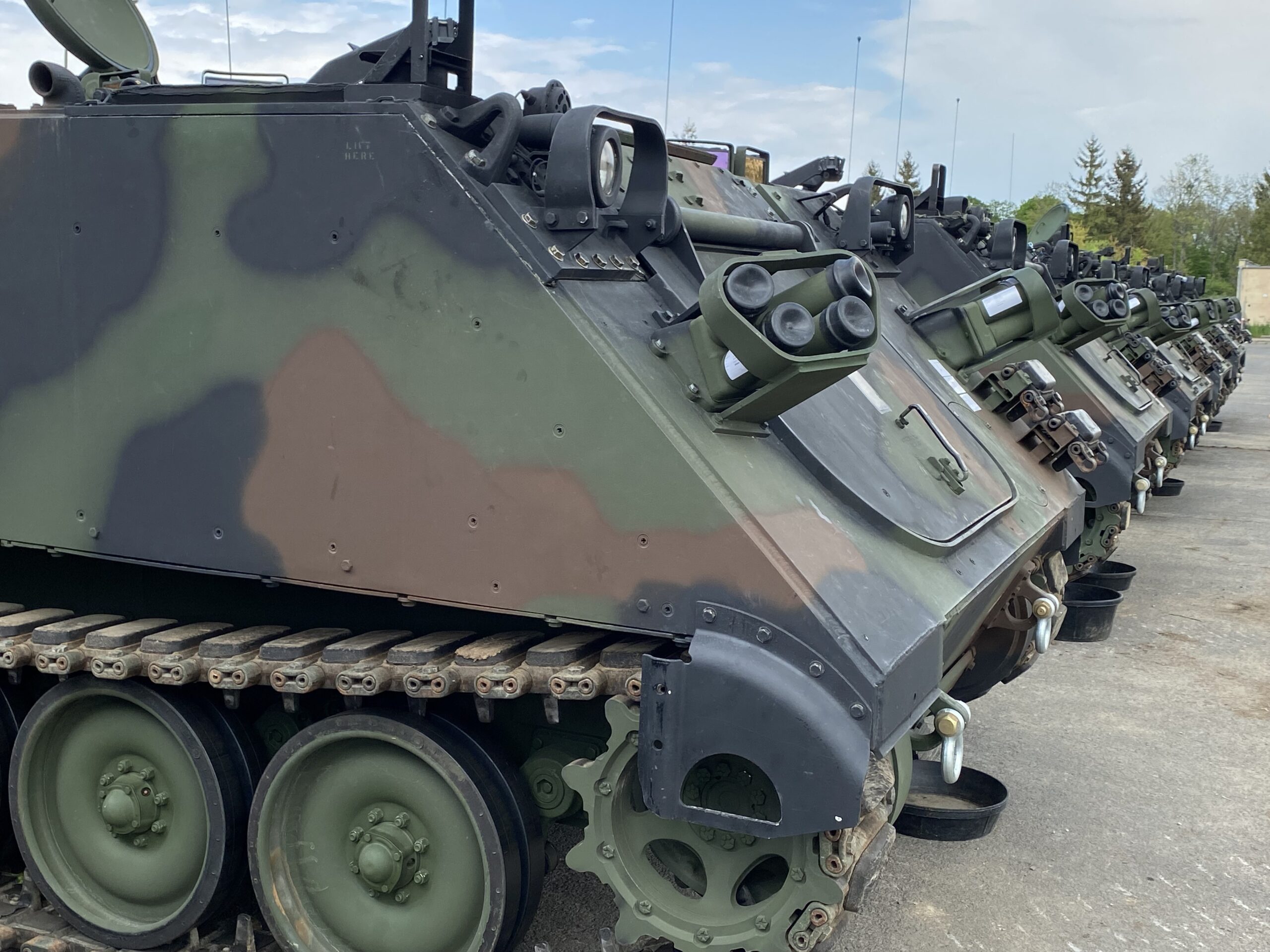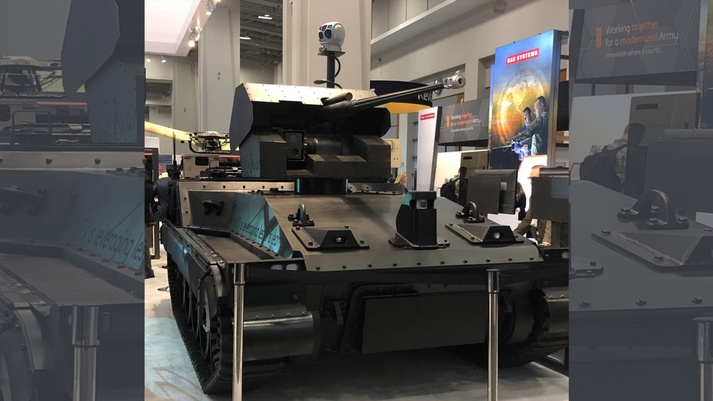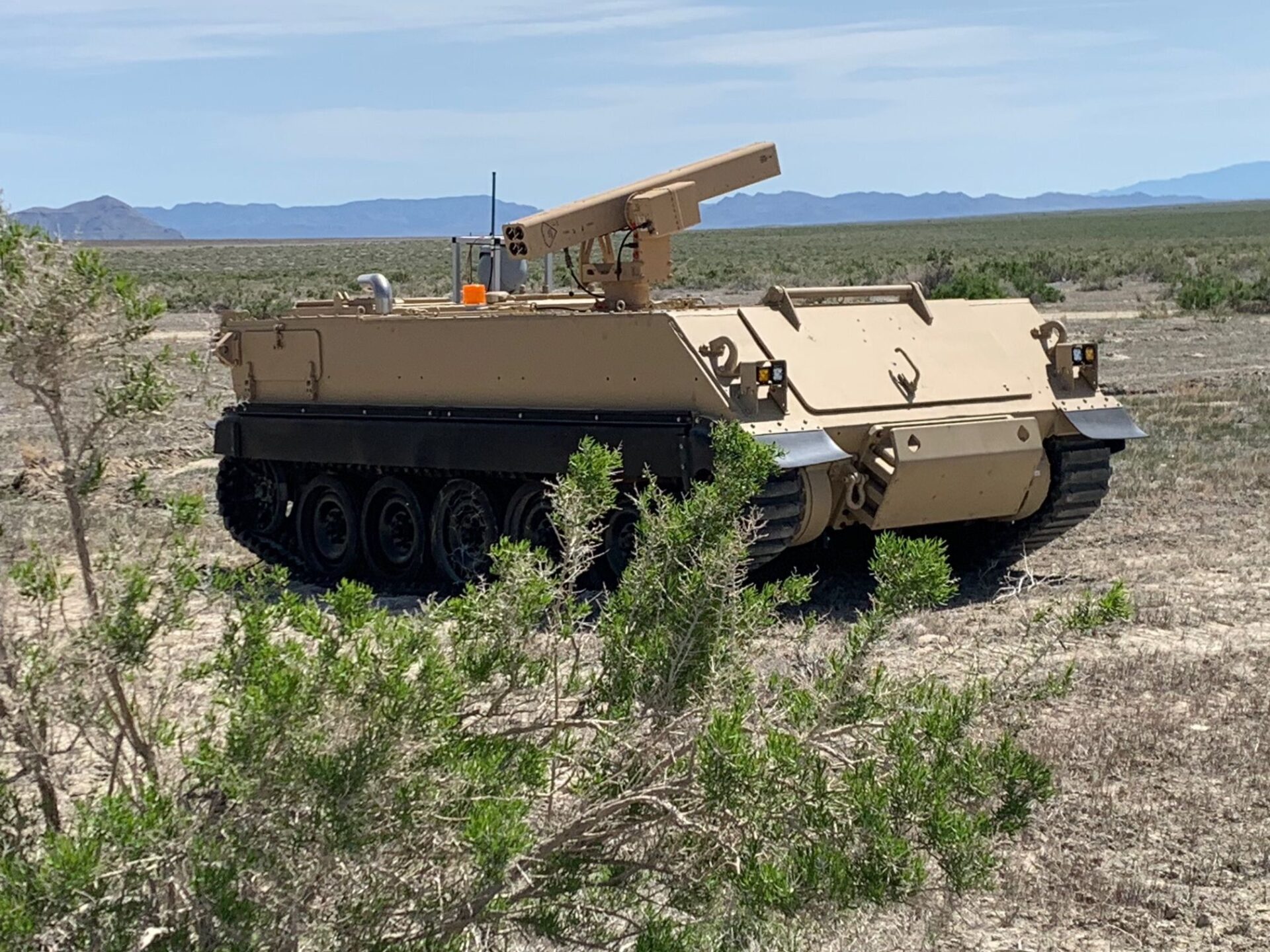A heavily modified version of the venerable M113 armored personnel carrier showed up at the Army’s recent EDGE 22 technology demonstration at Dugway Proving Ground in Utah sporting a remote weapon station armed with a guided rocket launcher. The vehicle belongs to the Artificial Intelligence Integration Center (AI2C), the Army Futures Command office responsible for studying the use of AI to control battlefield systems.
A photo posted to Twitter by Ronkainen shows what is identified as a version of BAE Systems’ Robotic Technology Demonstrator based on an M113 hull that has been cut down. The lower profile is evident because the engine hatch hinge is now above the topline of the vehicle.

The Army has long used M113s to support its Robotic Combat Vehicle (RCV) program and other unmanned ground vehicle initiatives, but they are typically legacy manned armored personnel carriers (APCs) converted for use as unmanned systems. The appearance of a heavily modified uncrewed version of the vehicle in the Utah desert is a first.
The demonstrator is topped with an Electro Optic Systems R150 weapon station equipped with a thermal-imaging camera and laser range finder. It can mount weapons up to a .50 caliber heavy machine gun, or in this case, an Arnold Defense four-shot LAND-LGR4 laser-guided weapon system launcher that is compatible with 70mm advance precision kill weapon system (APKWS) guided rockets. It is unclear from the photo what type of rockets were loaded into the launcher.

BAE Systems did not immediately confirm that the vehicle is one of its demonstrators. An Army spokesperson said the vehicle was operated at EDGE 22 by the AI2C Cross-Functional Team (CFT). The exercise is part of a series of rolling experimentation exercises hosted by the Army to evaluate new technologies and operational concepts and was the first time the demonstrator has been seen ‘in the wild.’
BAE unveiled its first robotic armored vehicle demonstrator at the Association of the U.S. Army’s 2019 expo in Washington, D.C., though that vehicle does not resemble the one seen in the picture from EDGE 22. Both sport rubber tracks, which are not the default configuration for Army M113s. Rubber tracks have been pitched for heavy combat vehicles to reduce weight, vibration and noise but those advantages are largely to improve the ride comfort of human passengers. Unlike steel tracks, rubber also lessens damage to roadways and provides improved fuel efficiency on prepared surfaces with a lighter logistics burden.
In 2019 James Miller, director for business development at BAE Systems Combat Vehicles, called the robotic demonstrator a “rolling lab” for testing emerging autonomy and weapon capabilities. FMC Corp. built the original M113 before transferring production of the vehicles to subsidiary United Defense in 1994. BAE bought that company in 2005 and now produces the APCs. It is developing an array of robotic combat capabilities, some using the M113 chassis.

“The electrical infrastructure, advanced optics, and software that have been integrated onto this highly reliable and robust chassis provides the foundation for truly game-changing battlefield capability,” Miller said. “BAE Systems built this demonstrator to help us determine the best way to mitigate risk for our soldiers while increasing their lethality.”
That vehicle was fitted with a hybrid-electric drive to improve fuel efficiency, sensors to provide 360-degree situational awareness to the remote operator, and the aforementioned composite rubber tracks. The version displayed at the 2019 AUSA conference was armed with a 30mm remote weapon station and a legged sidekick robot that can perform reconnaissance missions, according to BAE.
EDGE 22 wrapped on May 18 after two weeks of demonstrations led by the Future Vertical Lift Cross Functional Team (FVL CFT). At least 20 other Defense Department organizations participated, including other CFTs, the Army’s ISR Task Force, and the Artificial Intelligence Integration Center, which fielded the robotic technology demonstrator.
It is unclear what technologies or scenarios the modified M113 was testing in Utah, but in the hands of AI2C, it was likely operating with some level or artificial intelligence within the larger exercise. The service has been hunting for unmanned ground vehicles (UGVs) of various sizes and capabilities for years. In most case the technologies tested are capable of some degree of semi-autonomous operation but human soldiers remain in the loop at all times with direct control of onboard weapons and sensor systems.
The Army has on several occasions used its surplus M113s as surrogates for robotic combat vehicle (RCV) technologies. In 2020 during live-fire exercises at Fort Carson, Colorado, four M113-based RCVs were controlled by soldiers in modified crewed Bradleys called Mission Enabling Technologies-Demonstrators, or MET-Ds.

Soldiers tested the ability to control and maneuver the RVCs and whether the semi-autonomous vehicles increased the lethality and efficiency of ground units. The M113 RCVs were fitted with 360-degree cameras and 7.62mm remotely operated machine guns. Soldiers inside the MET-Ds could control the RCVs out to 2,000 meters but struggled to extend that distance in dense forest.
More than 80,000 M113s were built in 40 variants that are in service with 44 militaries worldwide. They are solid vehicles that may be too lightly armored to protect troops against modern weapons, but have a variety of other applications. Enough of the vehicles are in its inventory that the U.S. military is sending 200 of the APCs to reinforce Ukraine in its war against Russia. Several other countries, including Australia, also are sending M113s to Ukraine. The APC has seen duty as firefighting vehicles, a NASA HAZMAT response vehicle and as mortar carriers.
A low-profile, remotely operated or semi-autonomous version of the M113 could offer the Army a lower-cost option for fielding robotic combat vehicles. With no crew on board, survivability is less of an issue, and there will be an even greater surplus of the legacy tracked vehicles as the Armored Multipurpose Vehicle (AMPV), also built by BAE Systems, fields with U.S. Army units.
The War Zone has reached out to both BAE and the Army to find out more about the vehicle and what role it played at EDGE 22. We will update this post as more information is available.
Contact the author: Dan@thewarzone.com
